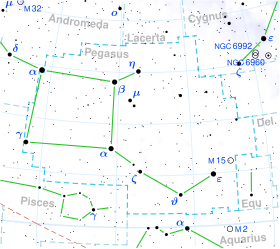Top Qs
Timeline
Chat
Perspective
Gamma Pegasi
Variable B-type star in the constellation Pegasus From Wikipedia, the free encyclopedia
Remove ads
Gamma Pegasi is a binary star in the constellation of Pegasus, located at the southeast corner of the asterism known as the Great Square. It has the formal name Algenib /ælˈdʒiːnɪb/;[12][13] the Bayer designation Gamma Pegasi is Latinized from γ Pegasi and abbreviated Gamma Peg or γ Peg. The average apparent visual magnitude of +2.84[4] makes this the fourth-brightest star in the constellation. The distance to this system has been measured using the parallax technique, yielding a value of roughly 470 light-years (144 parsecs).
Remove ads
Nomenclature
Gamma Pegasi is the star's Bayer designation. Although it also had the traditional name Algenib, this name was also used for Alpha Persei. In 2016, the International Astronomical Union organized a Working Group on Star Names (WGSN)[14] to catalog and standardize proper names for stars. The WGSN's first bulletin of July 2016[15] included a table of the first two batches of names approved by the WGSN; which included Algenib for this star (Alpha Persei was given the name Mirfak).
The asterism of γ Pegasi and α Andromedae, in Hindu astronomy, is called Uttara Bhādrapadā (उत्तरभाद्रपदा) or Uttṛṭṭāti. It is the 26th nakshatra. In Chinese, 壁宿 (Bìxiù), meaning Wall (asterism) refers to an asterism consisting of γ Pegasi and α Andromedae .[16] Consequently, the Chinese name for γ Pegasi itself is 壁宿一 (Bìxiù yī, English: the First Star of Wall.)[17]
Remove ads
Properties
Summarize
Perspective

In 1911, American astronomer Keivin Burns discovered that the radial velocity of Gamma Pegasi varied slightly. This was confirmed in 1953 by American astronomer D. Harold McNamara, who identified it as a Beta Cephei variable.[5] (At the time he actually identified it as a Beta Canis Majoris star, which was subsequently designated a Beta Cephei variable.)[19] It pulsates radially with a period of 0.15175 days (3.642 hours), but also shows the behavior of a slowly pulsating B star (SPB) with three additional pulsational frequencies.[5] Hence it is considered a hybrid pulsator.[20] Its magnitude varies between +2.78 and +2.89 over the course of each pulsation cycle.[2] In 2025, interferometric observations discovered a companion around the star.[21]
The primary is a large star with 8.8 times the mass of the Sun and 5.5 times the Sun's radius.[8] The stellar classification of B2 IV[3] suggests this is a subgiant star that is exhausting the hydrogen at its core and is in the process of evolving away from the main sequence. With a projected rotational velocity of 8 km/s, it is either rotating very slowly or it is being viewed from nearly pole-on.[10] Gamma Pegasi A has a total luminosity of 6,000 times that of the Sun, which is being radiated from its outer atmosphere at an effective temperature of more than 22,000 K.[8] At this temperature, the star glows with a blue-white hue.[22] Algenib has a weak magnetic field (from -10 G to 30 G,[23] an upper bound on a dipolar magnetic field strength of about 40 G[24]).
The secondary has an angular separation of 85.6±0.1 mas from its primary, little is known about it.[21]
Remove ads
References
External links
Wikiwand - on
Seamless Wikipedia browsing. On steroids.
Remove ads

